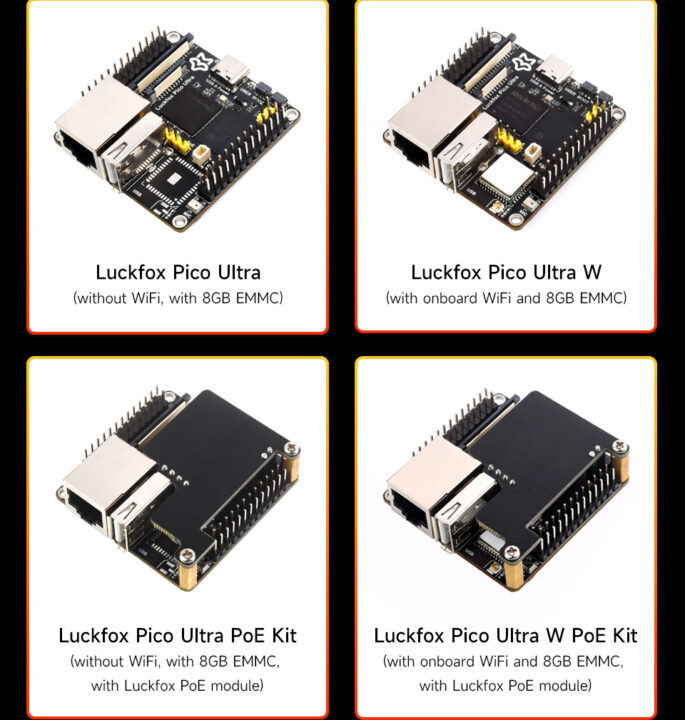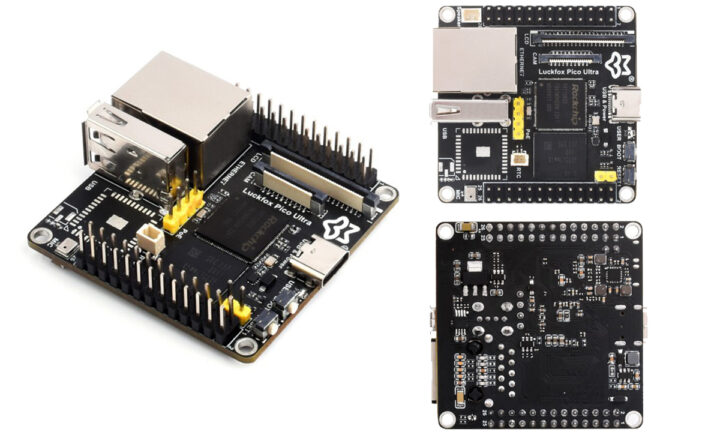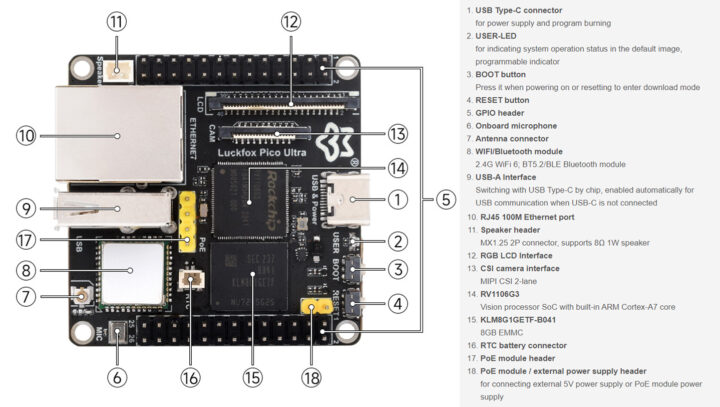The Luckfox Pico Ultra is a Rockchip RV1106-based Linux micro development board with a MIPI CSI port, an Ethernet port, and a 0.5 Tops NPU to run AI and image processing applications. Additionally, it features a speaker header, RGB LED header, GPIO, UART, SPI, I2C, USB, and much more.
Waveshare also offers a “W” version of the Pico Ultra with built-in 2.4 GHz Wi-Fi 6 and Bluetooth 5.2. If you want to add PoE support, you can connect to the board with a separate PoE module.
Luckfox Pico Ultra Specifications
- SoC – Rockchip RV1106G3
- CPU – Arm Cortex A7 @ 1.2GHz with an integrated RISC-V co-processor.
- NPU– 0.5 TOPS, supports INT4/INT8/INT16, TensorFlow/MXNet/PyTorch/Caffe/Onnx NN
- ISP – 5MP high-performance, HDR, WDR, 3DNR, 2DNR, sharpening, defogging, fisheye and gamma correction, feature detection
- VPU – 3072×1728 (5M) @ 30fps H.265/H.264 encoding, 16M @ 60FPS JPEG snapshot
- System Memory – 256MB DDR3L
- Storage – 8GB eMMC flash
- Display Interface – RGB666 LCD Interface
- Camera Interface – 2-lane MIPI CSI
- Audio – Onboard microphone, Speaker header
- Connectivity
- 10/100Mbps Ethernet controller and embedded PHY with optional PoE
- 2.4GHz WiFi 6 and Bluetooth 5.2/BLE (Available only in Luckfox Pico Ultra W)
- USB
- 1 x USB-C port
- 1 x USB-A port (Switching with USB Type-C by chip, enabled automatically for USB communication when USB-C is not connected)
- GPIO – 2x 26-pin GPIO headers
- Misc
- BOOT and RESET buttons
- User LED
- RTC battery connector
- PoE module header
- Power Supply – 5V via USB-C port or PoE port (802.3af Compatible)
- Dimensions – 50 x 50 mm
In terms of features, the board is very similar to the LuckFox Pico Pro and Pico Max which we wrote in February this year. The only difference is that the new Pico Ultra board features a different form factor and the option to add a wireless module and/or PoE support. LuckFox also offers a Rockchip RV1103 powered pico board which you can check out if you are looking for similar products.
The Rockchip RV1106G3 features the fourth-generation Rockchip NPU unit that supports int4, int8, and int16 hybrid quantization meaning that this NPU can deliver 0.5 TOPS when using int8, and 1.0 TOPS with int4. Additionally, the chip features a third-generation ISP 3.2 with support for up to 5 megapixels camera module, High Dynamic Range and Wide Dynamic Range algorithms.
In terms of software, the board supports the buildroot and Ubuntu 22.04 systems allowing developers to choose the appropriate system based on project requirements.

The Luckfox Pico Ultra comes in four different versions, so you can choose the one that best fits your needs. You can find more details about each version and other details on the Waveshare wiki page.
The Luckfox Pico Ultra deve board can be purchased on AliExpress for $26.27 and up depending on options such as WiFi and/or PoE, and it should soon become available on Waveshare Amazon store. Alternatively, you can purchase the board from Waveshare’s official store where it is sold for $17.99 to $29.99 depending on the configuration but the Waveshare price dose does not include shipping.
Debashis Das is a technical content writer and embedded engineer with over five years of experience in the industry. With expertise in Embedded C, PCB Design, and SEO optimization, he effectively blends difficult technical topics with clear communication
Support CNX Software! Donate via cryptocurrencies, become a Patron on Patreon, or purchase goods on Amazon or Aliexpress







I was curious about the 2.4GHz WiFi 6 and Bluetooth 5.2 module, so I checked the Wiki.
It’s the AIC8800DC. It’s also used in some USB WiFi adapters from Tenda and other brands. These cost less than $3 on Aliexpress.
The AIC8800 is also found in Lichee Console 4A mini laptop and Avaota A1 SBC
I had some fun with some other Luckfox RV1103 based board fairly recently:
https://megous.com/dl/tmp/luckfox.txt 🙂
This ^^^ is a bootlog from Pico Mini: https://megous.com/dl/tmp/d3741d88d5ed8c66.png
RV1103 and 1106 are pretty much the same. Only annoyance is that there’s no datasheet.
I can find a few RV1103 and RV1106 datasheets (albeit only 24 pages). Do you mean the TRM is missing?
Yes.
There’s no mainline support for the SoC, currently. I had to forward port clock driver from Rockchip BSP and patch up a few other drivers to get it to boot on Linux 6.10 and have USB and sdmmc working.
Anyway, I don’t see value in Pico Ultra, too big/expensive and there are better supported boards with similar features/price. But Pico Mini is a very small Linux supporting board and it’s great for making Linux based USB gadgets.
How different are the RV1103 and RV1106 from the RV1108 and RV1109 which already have support in mainline Linux?
I’d say quite different. RV1106/3 seem newer, featuring IPs that are available in newer RK SoCs like RK35xx. Boot ROM is also newer, similar to the one in RK35xx in implementation.
Anyway, getting upstream support for everything outside of video features is rather simple. I’m already there, and I will be sending out patches soon.
I’d also guess that it RV1106 has NPU similar to RK35xx except less performant, but didn’t check in detail.
Interesting. Do you have these patches available somewhere by any chance? Asking for a friend…
It will be available here https://codeberg.org/megi/linux in one of the branches. I’ll probably name it luckfox-6.10 or something like that.
And it’s there: https://codeberg.org/megi/linux/commits/branch/luckfox-6.10
Awesome! I’ll try to give it a go on rv1106, since that’s what I have.
Thanks again!
It’s a bit of a weird combination of features, isn’t it? On the one hand your have 3K video, AI acceleration, camera processing, Wi-Fi, Ethernet, and it runs Linux, on the other hand you only have 256 MB RAM, no HDMI, no 5 GHz WiFi… It looks like it’s tailored for a pretty specific set of use cases (probably AI assistants a la Alexa/Google Home?), though I wonder if one needs such a small board if you want to pair it with a 3K screen, and the 256 MB RAM must quickly be a limiting factor for many applications.
The problem with these boards is the lack of support for cameras; it only supports few basic cameras at specific resolution/framerate:
https://github.com/LuckfoxTECH/luckfox-pico/tree/main/media/isp/release_camera_engine_rkaiq_rv1106_arm-rockchip830-linux-uclibcgnueabihf/isp_iqfiles
This doesn’t seem to fare well against the Mikly-V DUO S
This device Is currently most used for the jailbreaking of the Playstation 4 (with firmware 11.00 or less, they have a vulnerability on PPPoE client), acting as a PPPoE Server and injecting the exploit in order the PS4 can be jailbroken.
It’s an alternative to pi02w, without wireless (it’s not really needed for jailbreaking, if you don’t use PPPoE bridging) buy having an ethernet on a little pcb.